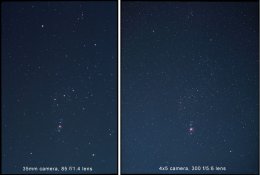Lee L
Member
- Joined
- Nov 17, 2004
- Messages
- 3,281
- Format
- Multi Format
When astronomers talk about sky glow, they're talking about man-made artificial light or the moon lighting up earth's atmosphere, local stuff, not what's out beyond our atmosphere, and definitely not the glow from our galaxy, nebulae, etc. This atmospheric sky glow overwhelms and limits what you can see of space.
As for aperture, a telescope's limiting magnitude for viewing pinpoint sources like stars is calculated with the formula: 7.5 + 5 x log(aperture in cm) For photography, about 2 magnitudes are added because the film can accumulate light over time, unlike the eye. The quality and condition of the glass, mirror coating, light loss due to large numbers of glass elements, etc, come into play, but not focal length.
If you don't want to believe this or research it, that's fine by me. My wife has students that "don't believe in graphs". You could test it for yourself by setting two different lenses to the same physical aperture in mm and shooting the same film under identical conditions. The wider field lens will see more stars across the sky that appear more crowded, but if you look at the same section of sky seen in the longer f.l. lens, you won't see any more stars, even though you used a "faster" f-stop on the shorter lens.
Lee
As for aperture, a telescope's limiting magnitude for viewing pinpoint sources like stars is calculated with the formula: 7.5 + 5 x log(aperture in cm) For photography, about 2 magnitudes are added because the film can accumulate light over time, unlike the eye. The quality and condition of the glass, mirror coating, light loss due to large numbers of glass elements, etc, come into play, but not focal length.
If you don't want to believe this or research it, that's fine by me. My wife has students that "don't believe in graphs". You could test it for yourself by setting two different lenses to the same physical aperture in mm and shooting the same film under identical conditions. The wider field lens will see more stars across the sky that appear more crowded, but if you look at the same section of sky seen in the longer f.l. lens, you won't see any more stars, even though you used a "faster" f-stop on the shorter lens.
Lee














